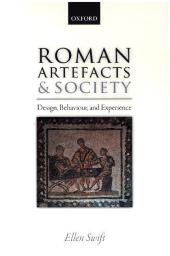 Neuerscheinungen 2017Stand: 2020-02-01 |
Schnellsuche
ISBN/Stichwort/Autor
|
Herderstraße 10
10625 Berlin
Tel.: 030 315 714 16
Fax 030 315 714 14
info@buchspektrum.de |

Ellen Swift
Roman Artefacts and Society
Design, Behaviour, and Experience
2017. 320 S. 241 mm
Verlag/Jahr: OXFORD UNIVERSITY PRESS 2017
ISBN: 0-19-878526-7 (0198785267)
Neue ISBN: 978-0-19-878526-2 (9780198785262)
Preis und Lieferzeit: Bitte klicken
The book examines Roman artefacts using design theory to shed new light on our understanding of the relationship between the design and function of objects, and on aspects of Roman behaviour and experience. It examines how artefacts are designed for particular categories of users and what the implications are for discrepant experience.
In this book, Ellen Swift uses design theory, previously neglected in Roman archaeology, to investigate Roman artefacts in a new way, making a significant contribution to both Roman social history, and our understanding of the relationships that exist between artefacts and people. Based on extensive data collection and the close study of artefacts from museum collections and archives, the book examines the relationship between artefacts, everyday behaviour, and experience. The concept of ´affordances´-features of an artefact that make possible, and incline users towards, particular uses for functional artefacts-is an important one for the approach taken. This concept is carefully evaluated by considering affordances in relation to other sources of evidence, such asuse-wear, archaeological context, the end-products resulting from artefact use, and experimental reconstruction. Artefact types explored in the case studies include locks and keys, pens, shears, glass vessels, dice, boxes, and finger-rings, using material mainly drawn from the north-western Romanprovinces, with some material also from Roman Egypt.The book then considers how we can use artefacts to understand particular aspects of Roman behaviour and experience, including discrepant experiences according to factors such as age, social position, and left- or right-handedness, which are fostered through artefact design. The relationship between production and users of artefacts is also explored, investigating what particular production methods make possible in terms of user experience, and also examining production constraints that haveunintended consequences for users. The book examines topics such as the perceived agency of objects, differences in social practice across the provinces, cultural change and development in daily practice, and the persistence of tradition and social convention. It shows that design intentions, everyday habits of use, and the constraints of production processes each contribute to the reproduction and transformation of material culture.
What Swift has produced is a unique contribution to material culture studies which provides a set of tools for thinking with and about everyday objects. It is rare to find such sensitive and nuanced theoretical discussion combined with a grounded focus on archaeological data, and Swift´s book deserves to be widely read. Julia Farley, Journal of Roman Studies


